|
The
UAE is blessed in many ways and one of these is that
within this rather small country there are many
different landscapes. Geologists would say: the
topography varies from coast to coast. On the Arabian
Gulf coast are low-lying sabkha flats and small mangrove
stands bounded by calcareous dunes. Further inland are
lightly vegetated sandy deserts of varying chemical
composition, which in turn give way to gravel plains and
wadis as the Hajar mountain range is approached. The
mountains rise to 1200 meters within the UAE (but up to
2800 m. further north in the Musandam Peninsula) and
contain bare, rocky peaks, cut by deep, winding wadis.
Each of these habitats has its own micro-climate and
micro-environment, which in turn affects the
distribution of the flora and fauna. Parallel to the
Hajar Mountains and a few kilometers inland there is a
range of lower limestone mountains. These used to be the
beaches of an ancient sea – the sea of Tethys. When
volcanic action at the bottom of this sea caused the
ocean bottom to rise and fold (and form the Hajar
Mountains), the beaches also rose and folded and now
form fossil bearing hills dating from the Tertiary era.
The Jebel Hafeet anticline is the largest of several
Tertiary antiforms, aligned along the western flanks of
the Hajar Mountains. The massive mountain is cut by
several wadi systems that flow out on both the eastern
and the western side.
It rises nearly 1300 m above sea level and is located
immediately south of Al Ain, straddling the border
between the UAE and Oman. It is easily visible from
space. From below it looks like a “beached whale”, as
Wilfred Thesiger once described it. It is asymmetrical –
on the west it dips at about 25 to 30 º while on the
east it is much steeper. Faults are abundant and include
normal (extensional), strike-slip (wrench) and reverse
(thrust) types. To geology students it is of special
interest, because the mountain is eroded in such a way
that the composing layers can be easily observed at the
surface. In geology jargon Hafeet is the type locality
for two major formations: the Hafeet formation and the
Seniya formation. (A third formation present is called
the Al Jaww formation). Both are rich in deep sea
planktonic fossils called foraminifera. At the foot of
the mountain, close to where the road from the cement
works passes through a man-made gap, fossils of
branching corals, oysters, gastropods and more rarely
sea urchins and pieces of barnacles and crab claws can
be found. One type of fossil that is special to this
mountain is called ‘nummulites’. When I first found
these, they reminded me of potato chips – thin round
pieces of rock, often a bit curved. Where they are
broken, a delicate structure of round and transverse
septums can be seen. These nummulites are the remains of
a now extinct one-celled organism, varying in size from
3 to 15 mm.
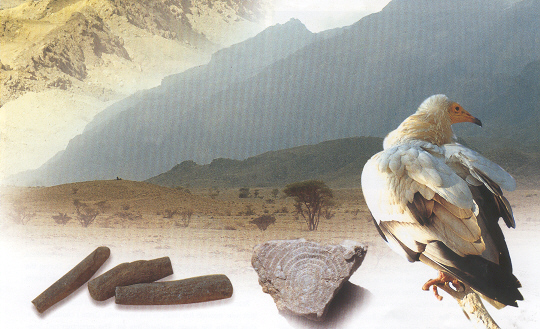
For non-geologists like myself, the mountain and the
surrounding area have many other interesting features.
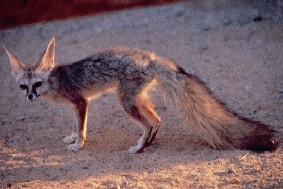
In fact, the mountain is so special that it was surveyed
intensively in 1997-1998 with a view to having it
pronounced a national heritage site or nature reserve.
The report of this survey organized and financed by the
Emirates Natural History Group (Abu Dhabi) makes
fascinating reading for anyone wanting to explore the
mountain. Unfortunately to this date the area has not
been declared a reserve officially and that has some sad
consequences. For the sandy plain at the foot of the
northern tip of the mountain was the one and only place
in the Emirates where the pretty yellow composite plant
called Anvillea garcinii was found. The last time
I searched for the plant (in 2003) the whole area had
been destroyed by indiscriminate criss-cross driving,
while the drought of many years had also taken its toll.
No live plants could be found at that time and it is
quite possible that by now this rare plant has become
extinct in the UAE. We did see the very fast-moving
lizard Acanthodactylus opheodurus – another
rarity, running between the dry bushes. The wadi that
runs out of the mountain onto this plain is called wadi
Tarabat, the finding place of the nummulites
fossils. A bit higher up in the valley are the only UAE
specimens of the large bush Acridocarpus orientalis,
while on the main part of the mountain lives the elusive
little ungulate the Arabian tahr. The tahr, a delicate
small goat-like animal, was thought to have been extinct
in the UAE since 1982 when a carcass was found near a
water hole on Jebel Hafeet. However, after the tahr was
rediscovered in the Hajar mountains in 1995, a male tahr
was seen near one of the parking lots by bird watchers
in 1997. Since then several other records have been made
by local environmentalists. During the ENHG survey the
presence of the small mountain fox Vulpes cana
was comfirmed by Chris and Tilde Stuart, South African
wildlife researchers, who had made the first record of
this pretty fox during their 1995 survey of the Hajar
mountains. There are also Red foxes (Vulpes vulpes)
to be found on the mountain. They seem to use the
mountain as a base from which to make feeding forays
into surrounding desert and farm areas.
Introduced to the mountain as an escapee from a local
animal collection was the rock hyrax (Procavia
capensis) - a small rodent, common in Africa and
indigenous to more southern parts of Arabia. It used to
be a favourite food of the Arabian leopard (Panthera
pardus nimr) that still occurs in small numbers in
the Hajar mountains. The hyrax on Jebel Hafeet should be
safe from leopards as it is unlikely that the Arabian
leopard ever occurred there. Whether the colony survived
the recent long years of drought is another matter. No
recent records are available at the time of writing
this.
Tortuous cave systems have been carved into the mountain
when vast volumes of water percolated into the bedrock
via open and interconnected fractures and through the
more permeable limestones. Several such systems have
been explored to a depth of 150 to 450 feet. Some caves
contain excellent stalactites, stalagmites and other
cave tufas. These caves were home to up to seven species
of bats, the most common being the Muscat Mouse-tailed
bat (Rhinopoma muscatellum). Unfortunately, most
of the accessible caves have either been blocked by the
Al Ain Municipality for safety or have been plugged
naturally by sediment fill.
For bird lovers the Hafeet mountain is unique because of
its special suite of species, not found in any other
mountain area of the UAE.
Up until the early 1980’s huge Lappet-faced vultures (Torchos
tracheoliotos) nested on the mountains and for many
years it has been home to a thriving colony of Egyptian
vultures (Neophron percnopterus). They lead an
easy life, finding food in Al Ain zoo that is located at
the foot of the mountain. Other birds of interest to
visiting twitchers are Hume’s wheatear (Oenanthe
alboniger) as well as the Hooded wheatear (Oenanthe
monacha) on the lower slopes, while Rock doves (Colomba
livia), Barbary falcons (Falco pelegrinoides)
and Brown-necked ravens (Corvus ruficollis) can
be found on the summit. The Jebel Hafeet Survey report
records no less than 119 species of bird residing in,
visiting or passing through the Jebel Hafeet area.
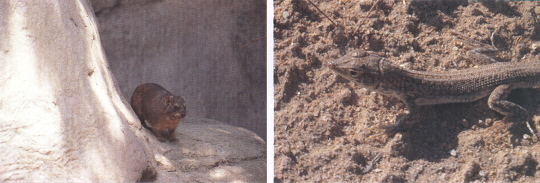
Insectwise the mountain is also a lot less empty than
one would think. Over the last decade Mike Gillet has
made extensive studies of UAE insects, and his species
list for Jebel Hafeet reaches far over 200 while he
himself points out that this list is not exhaustive.
Some of his recorded species are as yet unidentified. Of
interest to casual visitors of the mountain are the
butterflies, grasshoppers, and scorpions. The
butterflies are represented by 23 species, of which the
Common Swallowtail (Papilio machaon) is the
largest. The Caper white (Anaphaeis aurota) is a
true migratory butterfly that has the Caper plant as its
food plant. Of the many species of grasshoppers the
odd-looking Towerhead grasshopper (Truxalis procera)
occurs in both a green and a light brown form. Scorpions
are nocturnal and will not be encountered very easily.
The large and dangerous Androctonus crassicauda
is not easily overlooked, if it is disturbed from its
dark hiding place.
Archeologists will be intrigued by the presence on the
north and east front of the mountain of 317 tombs dating
to 3200-2700 BC. Excavations of only 25 of these tombs
so far have yielded pottery, stone beads and bits of
copper, but no weapons from a culture that is unlike any
other found so far in the UAE. The pottery was not
locally made but imported from Mesopotamia. This
suggests that these people had trade links with
Mesopotamia. There was also trade with the Upper Gulf as
indicated by the find of a so-called “Dilmun” seal,
dated to the late third or early second millennium BC.
Hafeet type cairns are found all over the south-eastern
Arabian Peninsula – as far north as Khatt near Ras al
Khaymah and as far west as Umm an Nar island in Abu
Dhabi.
During the nineteen eighties a double lane highway was
constructed leading to the top of the mountain. Along
this road and on the summit several large parking lots
have been developed affording spectacular views across
the city of Al Ain to the north and the sand dunes of
the edge of the Empty Quarter to the west. More recently
palaces were built and a luxury hotel opened several
years ago. On the west side of the foot of the mountain
are some hot springs and a recreational area has been
established featuring a huge fountain in the middle of
pleasant park surroundings.
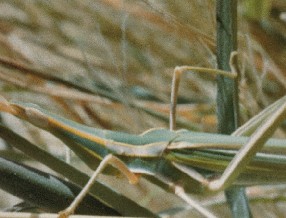
Even a drive on these tarmac roads can show the visitor
a little bit of the diverse nature that the mountain
harbours. Unusual plants like Iphiona scabra and
Cleome pruinosa can be found in the roadside
gullies, while among the rocky debris one can find
cherts, calcite crystals, marls and gypsum. Small
lizards (Phrynocephalus arabicus) can be spotted
sunning themselves on the rocks. Some of the stony
cliffs are festooned with caper plants (Capparis
cartilaginea) with their spectacular white flowers
that can only be seen open on early summer morning. In
fall, the fruits burst open when ripe, revealing a
blood-red pulp with many seeds. Other interesting,
though not very spectacular plants are Echiochilon
thesigeri, with its multi-coloured small flowers;
the small red pea flower of Tephrosia apollinea
and the rare Periploca aphylla with its strange
white-fringed maroon flowers. During the ENHG survey
over 200 species of perennial and annual plants were
recorded on Jebel Hafeet.
Standing on the last of the parking lots one can look
into a valley that runs through the heart of the
mountain. Once I climbed there, long before the roads
reached this far. The mountain had been truly “empty”
then (“hafeet” means “empty”), but only empty of people.
The presence of three hikers made no impression at all
on the vast silence of the big rock. We were specks on
the face of the cliffs.
I had sat down to enjoy the silence and the view. A rock
thrush in a nearby bush had sung its song for me. After
a while it flew up and glided towards me, landing
lightly on my head for just a moment before it flew on.

Around 500 million years ago, much of the Arabian
landmass was covered by shallow seas that evaporated
under the hot climate, leading to the formation of thick
salt deposits. Another ice age occurred in the
Carboniferous time some 400 million years ago. Later,
when Gondwana collided with Laurasia to form the super
continent of Pangea, more folding and faulting occurred
in Arabia. The seas flooded the area once again, in the
early Cretaceous, leading to the formation of shallow
water limestones, which now are the places where you can
find marine fossils. In the late Cretaceous, there was
movement originating from volcanic action in the seas to
the east. This caused the dark, dense crustal magma
extruded by the submarine volcanoes to be pushed up,
giving rise to a tremendously thick sequence of
so-called ophiolite rocks, which are the main type of
rock in the Hajar mountains. Ophiolites are typical of
such spreading centres and provide the geologist with
relatively rare access to rocks that are amongst the
most representative of the deepest parts of the Earth’s
crust. In fact, the ophiolites of the Hajar Mountains
are the most extensive in the world. In the hot and
humid climate they eroded rapidly.
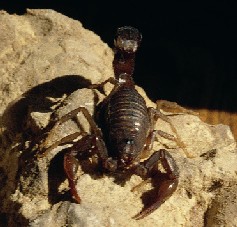
During the Palaeocene and Oligocene (65-23 million years
ago) sea levels rose and fell several times. The coastal
region was periodically covered with warm tropical
waters. After that the area became tectonically more
stable but it began to separate from Africa along the
Red Sea Rift about 25 million years ago and is currently
moving northwards at an average rate of 5 cm per year.
As it moved north and was pushed under Eurasia, the
Zagros mountains in Iran were formed. The straits of
Hormuz closed and in the rapidly subsiding basin thick
layers of salt and gypsum were deposited. The collision
caused large scale folding of the limestones, evidence
of which can be seen in Jebel Faiyah and Jebel Hafeet.
The UAE coast rose above sea level in the late Miocene/
early Pliocene (5 to 2 million years ago) and the
Arabian Gulf filled with water again about 4 millions
years ago. Fossil evidence shows that in the late
Miocene there were lush riverine valleys in the west of
Abu Dhabi with savannahs populated by elephant, giraffe,
rhinoceros and many other animals.
About 8000 years ago the lowered sea level allowed sand
to be blown into Abu Dhabi from Saudi Arabia and in the
last 6000 years the Arabian climate has become steadily
drier. | 